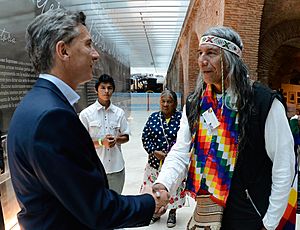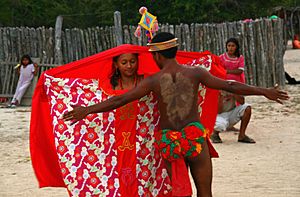Indigenous peoples of South America facts for kids
| Total population | |
|---|---|
| Approximately 18 million | |
| Regions with significant populations | |
| 5.9 million (2017) | |
| 4.1 million (2012) | |
| 2.1 million (2017) | |
| 1.9 million (2018) | |
| 1 million (2010) | |
| 955,032 (2010) | |
| 817,963 (2010) | |
| 724,592 (2011) | |
| 117,150 (2012) | |
| 78,492 (2012) | |
| ~100 | |
| 20,344 (2012) | |
| ~19,000 | |
| Languages | |
| Indigenous languages of the Americas, English, Spanish, Portuguese, French, Dutch | |
| Religion | |
|
|
| Related ethnic groups | |
| Indigenous people of the Americas | |

The Indigenous peoples of South America are the original groups who lived on the continent before Europeans arrived. Their descendants still live there today. These groups are different from people in South America whose families came from Europe or Africa.
In Spanish, these groups are often called indígenas or pueblos indígenas. This means "Indigenous peoples." Sometimes they are called pueblos nativos or nativos, meaning "Native peoples." In Argentina, the word aborigen is used. In Colombia, people often say pueblos aborígenes. In countries like Guyana, people might use the term "Amerindian." This is short for "Indians of the Americas."
Some people in South America have mixed family backgrounds. If someone has both European and Indigenous ancestors, they are often called mestizos (in Spanish) or mestiços (in Portuguese). If their family has both African and Indigenous ancestors, they are called zambos.
Contents
Early History of South America's First Peoples
Scientists believe the first people arrived in South America a very long time ago. One idea is that they came from Asia. They might have crossed a land bridge called Beringia into North America. From there, they slowly moved south into South America. Another idea is that some people might have traveled across the Pacific Ocean from Polynesia.
The oldest proof of people living in South America is at a place called Monte Verde in Southern Chile. This evidence shows people were there about 14,000 years ago. These first inhabitants were the ancestors of today's Indigenous peoples of South America.
Life Before European Arrival
Before Europeans came to South America, many Indigenous groups lived as hunter-gatherers. This means they found their food by hunting animals and gathering plants. Many groups in the Amazon rainforest still live this way today.
Other groups, especially those in the Andes Mountains, were skilled farmers. They grew many crops and used smart ways to water their fields, called irrigation. They also raised animals like llamas and alpacas. These animals were important for wool, meat, and carrying goods. The Inca Empire was one of the most famous and advanced of these farming cultures.
Indigenous Peoples Today
Today, Indigenous peoples are a very important part of South America. In some countries, they make up a large part of the population. For example, in Peru, about 45% of people are Indigenous. In Bolivia, about 62% of people identify as being part of an Indigenous group.
Many different Indigenous groups live across South America. Each group has its own unique language, traditions, and history. Here are some of the countries where Indigenous peoples live:
- Indigenous peoples in Argentina
- Indigenous peoples in Bolivia
- Indigenous peoples in Brazil
- Indigenous peoples in Chile
- Indigenous peoples in Colombia
- Indigenous peoples in Ecuador
- Indigenous peoples in French Guiana
- Indigenous peoples in Guyana
- Indigenous peoples in Paraguay
- Indigenous peoples in Peru
- Indigenous peoples in Suriname
- Indigenous peoples in Uruguay
- Indigenous peoples in Venezuela
See also
 In Spanish: Pueblos indígenas de Sudamérica para niños
In Spanish: Pueblos indígenas de Sudamérica para niños
- Indigenous peoples of the Americas
- Wars involving indigenous peoples of South America
- List of indigenous peoples
- Ceramics of indigenous peoples of the Americas


